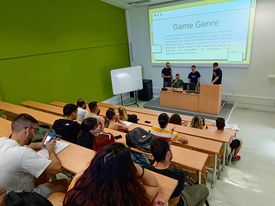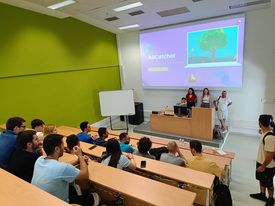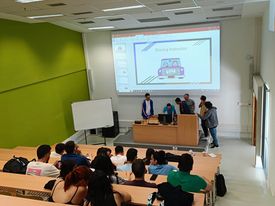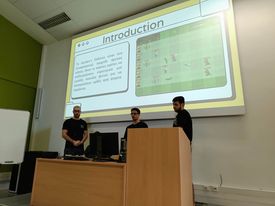
Description of the course
The course focuses on principles of game design and implementation. It addresses all aspects of game design, starting from the definition of a game concept, which focuses on a 3-minute pitch of a game to be implemented throughout the semester, including the game idea, target audience, game world, compelling features, camera models, single or multiplayer design, game genre, characteristic gameplay, story, game world, and marketing plan. Subsequently, the course follows through all steps of the game design process, including user analysis, game world design, story design, character design, puzzle design, gameplay, game balancing, level design, creative and expressive play, on-line games, serious games, and other aspects. The course address both theory and practice. Students design and implement in the UNITY® game development environment an actual game based by considering the lecture presentations. They present the game concept, game design, and final implementation in the class for the benefit of all participants. Upon completion of the course students have a good understanding of game design principles and are able to apply them in practice for developing actual games.
Description of the participants
This is an elective course in the undergraduate program of the Electrical and Computer Engineering Department of the University of Thessaly. Typically, the course is attended by 4th or 5th year undergraduate students, who are close to the completion of their studies. ICT-INOV was deployed both in the 2022 – 2022 and the 2022 – 2023 academic years.
In the 2021 – 2022 academic year, the course was attended by 124 students.
In the 2022 – 2023 academic year, the course was attended by 76 individuals.
Description of gamified design thinking activities
A learning activity based on design thinking was specifically designed for the course. The objective of the learning activity was to challenge students to design and implement a digital game with a learning focus. Students had the option to design a game that addresses the needs of a target group of their choice, such as primary or secondary school learners, higher education students, professionals, disadvantaged individuals, or other. Students further had freedom on selecting the game focus. Example topics included math, critical thinking, history, geography, team skills, or any theme related to formal educational curricula, soft skills, or informal learning.
Students worked of up to 6 individuals. The activity was structured as follows:
Step 1: Game concept.
Students were encouraged design a game concept addressing the following aspects: game objectives, user experience, learning focus of the game.
Step 2: User analysis.
Students were challenged to describe a characteristic user or player by considering aspects such as what is the target audience, what characteristics differentiate the target audience from other groups, and what challenges the audience likes. They were further encouraged to describe a typical player by describing the “user’s journey”, namely the experiences of the user throughout her life that make her the person that she is today, for example experiences in school, university, workplace, family, and more.
Step 3: Game mechanics.
Students were instructed to describe the core game mechanics, including physics rules, progression mechanics, game economy for trading resources, social dimension, tactical elements, game objects and attributes, relationships between game objects, sources and drains of resources, and more.
Step 4: Game world design.
Students were asked to design the game world, including the physical dimension, time elements such as day and night or seasons, values, emotional dimension, ethical dimension, style, mood, aesthetics, and more.
Step 5: Story design.
Students were challenged to introduce a story into the game by applying Vogler’s model. This model presents a structure to story design, starting from the ordinary world and moving to a call to adventure, refusal of the challenge by the hero, meeting a mentor, accepting the challenge, trials, enemies, and allies, reaching the largest conflict of the story, reward, and the road back.
Step 6: Character design.
Students were challenged to describe the main characters of the game. They were further asked to describe if the characters would be art- or story-based, the looks of the characters, and the behaviour. They were encouraged to introduce an avatar into the game and consider how the avatar would grow through the challenges and story.
Steo 7: Game balancing and final design.
Students were challenged to consider elements for balancing their game, namely making the game fair by ensuring that the challenges have an appropriate difficulty level that corresponds to the skill of the user.
Throughout the process, students used the ICT-INOV platform for publishing their ideas and collaborating through every step of the game design process. The platform encouraged students to build on each other’s ideas and allow them to collaborate from home in between class sessions.
Some examples of projects that students developed include:
- A game on raising awareness on COVID-19. An arcade game in which users collect items related to the fighting of COVID-19, such as vaccines and medication.
- A game on raising awareness on mental health. The game follows a character that ponders on her past experiences for discovering her strength and building confidence.
- A game on history. The game encourages the player to discover different history periods, such as ancient Egypt, ancient Greece, and the Roman empire.
- Math games. Diverse games on building early math knowledge in a playful manner.
- A game on raising awareness for air pollution. The game encourages players to limit the emissions of toxic gases.
- Arcade games that combine entertainment with knowledge building. The games combine popular mechanics, such as avoiding obstacles and collecting items, with questions for building knowledge on mathematics and other subjects of primary and secondary education curricula.
- A game on geography. A world trivia game challenges players to answer questions related to different continents, gaining badges and travelling the globe.
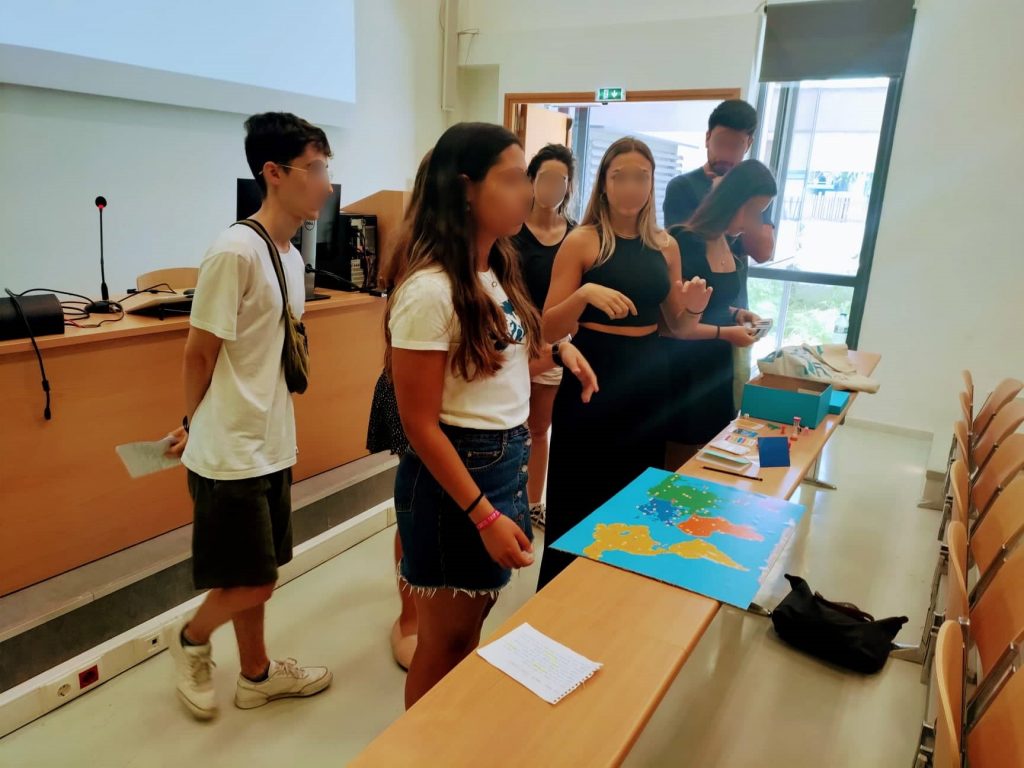

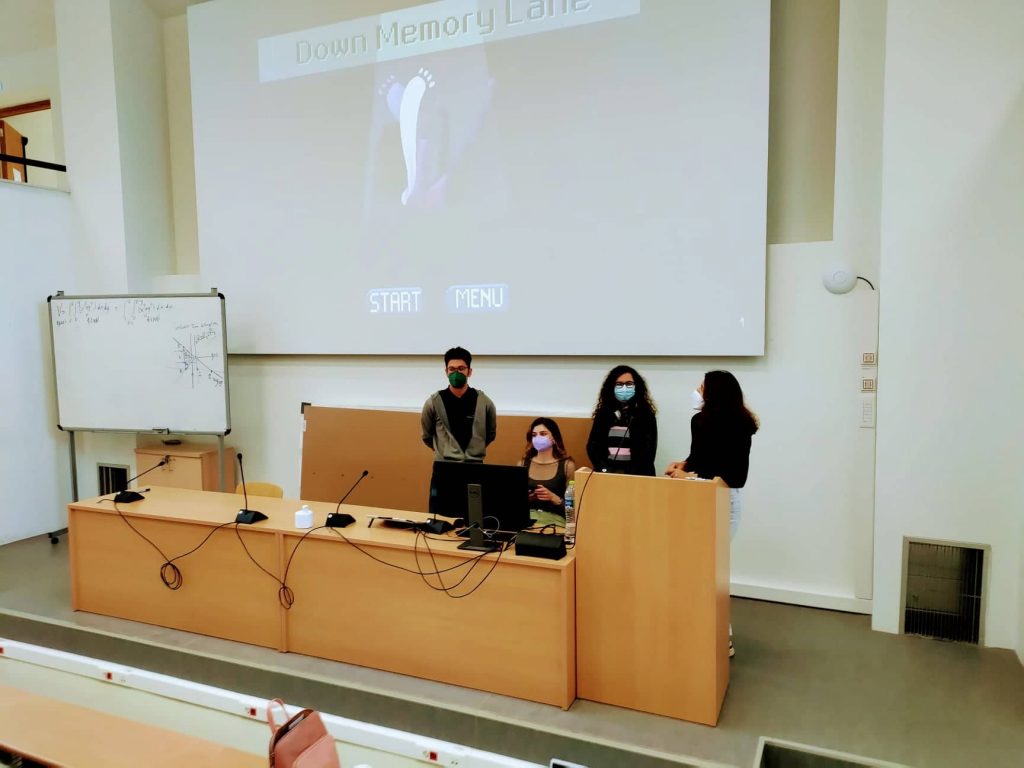
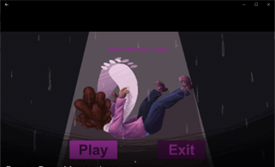
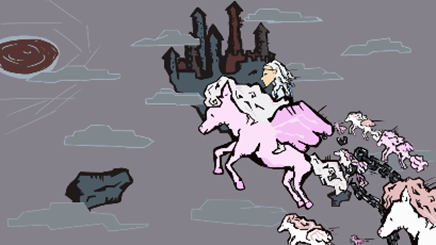
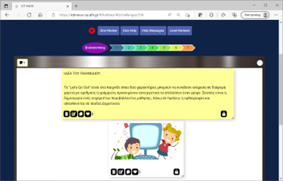
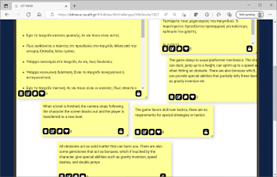
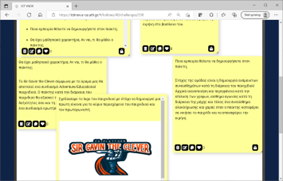
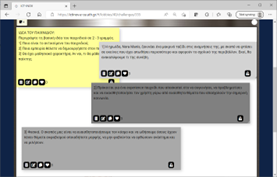
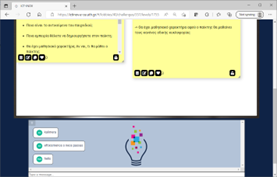


Some examples of projects that students developed in the 2021 – 2022 academic year include:
- A game on raising awareness on COVID-19. An arcade game in which users collect items related to the fighting of COVID-19, such as vaccines and medication.
- A game on raising awareness on mental health. The game follows a character that ponders on her past experiences for discovering her strength and building confidence.
- A game on history. The game encourages the player to discover different history periods, such as ancient Egypt, ancient Greece, and the Roman empire.
- Math games. Diverse games on building early math knowledge in a playful manner.
- A game on raising awareness for air pollution. The game encourages players to limit the emissions of toxic gases.
- Arcade games that combine entertainment with knowledge building. The games combine popular mechanics, such as avoiding obstacles and collecting items, with questions for building knowledge on mathematics and other subjects of primary and secondary education curricula.
- A game on geography. A world trivia game challenges players to answer questions related to different continents, gaining badges and travelling the globe.
Some of the projects developed in the 2022 – 2023 academic year include:
- A game on geography. A multiple-choice exercise on information related to countries around the globe.
- A strategy game. A game on strategic preparation of player defences for fighting enemies with different capabilities.
- A puzzle game or escape room for knowledge. A game through which players are encouraged to build critical and analytical thinking by discovering information and establishing associations between facts.
- Action – adventure games. Arcade games in which players are encouraged to overcome obstacles and avoid enemies while also responding to trivia questions.
- A driving rules game. An educational game on building awareness and knowledge on safe driving behaviour.
- Trivia snakes and ladders. A variation to the popular children’s game in which players are challenged to respond correctly to educational questions before receiving rewards, such as climbing a ladder that brings them closer to victory.
- Language games. Games on recognizing words and letters, suitable for young learners that may also face learning difficulties.
- Math games. Multiplication games for young learners, combined with game elements such as navigating a labyrinth.




